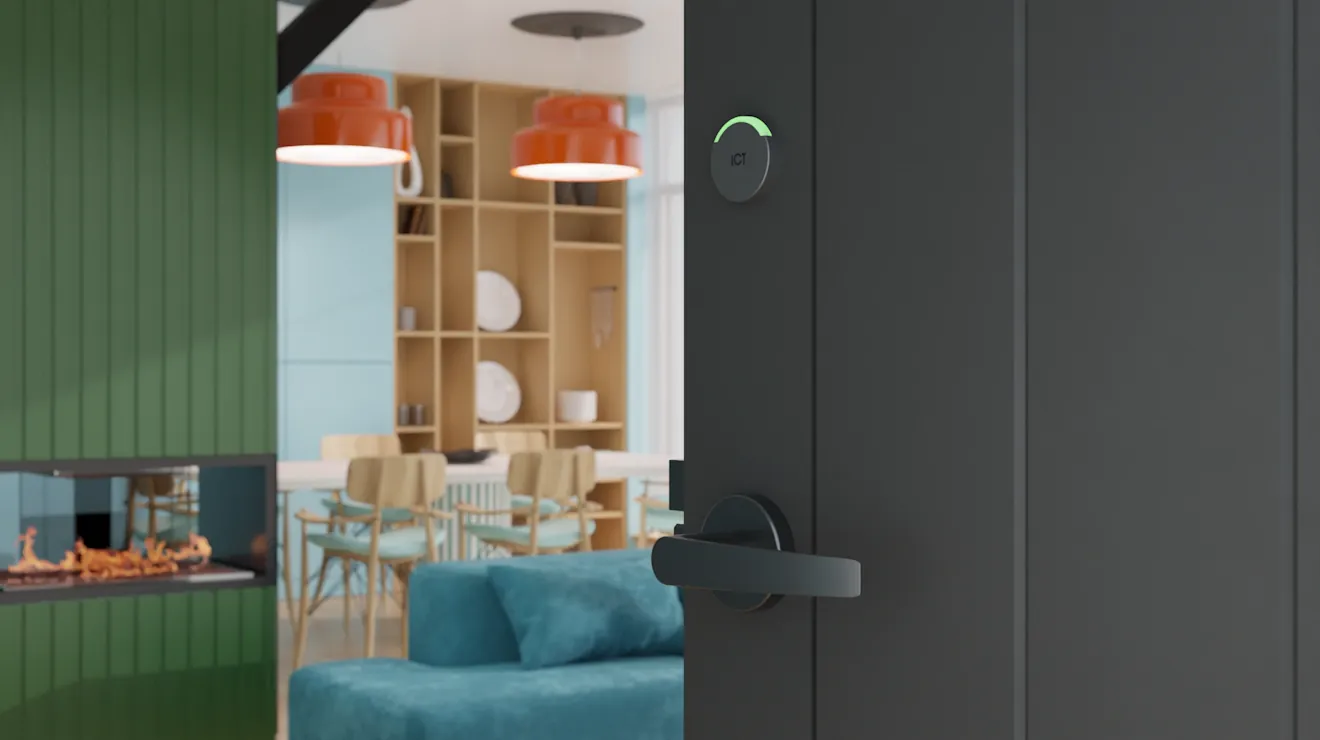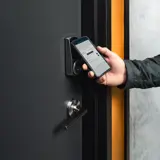
What Are Wireless Locks?
The Future of Smart, Keyless Access
Modern access starts with wireless locking technology
As buildings get smarter and security becomes more integrated, wireless locks have emerged as a flexible, intelligent alternative to traditional key systems. Whether it’s for residential use, a growing business, or a complex commercial property, wireless door locks are redefining how we manage access — no more keys or cables.
In this guide, we’ll break down how these systems work, unpack the benefits, compare lock types, and demonstrate how ICT Protege Wireless Locks and our integrated wireless locking solutions can be seamlessly incorporated into the access control systems for multifamily, commercial and other industries.
What are wireless locks and how do they work?
Wireless locks are electronic locks that use communication technologies like Bluetooth, Wi-Fi, Zigbee, or proprietary radio frequencies to connect to a central control platform. Instead of relying on a physical key or wired connection, these systems allow administrators to manage access remotely.
Along with Protege Wireless Locking range, the Protege platform also integrates directly with leading wireless lock manufacturers like ASSA ABLOY, Allegion, Salto, and Aperio, enabling full system control without additional middleware.
Wireless lock technology overview
| Communication Type | Description | Use Case Example |
| Bluetooth | Short-range, low-energy wireless connection | Wireless locks in apartment building connect to online hubs in the corridor |
| Wi-Fi | Internet-enabled lock for real-time remote access and management | Homeowners locking/unlocking remotely |
| Zigbee/Z-Wave | Low-power mesh networks, often used in smart home and building automation | Integrating locks with lighting and alarms |
| Data on Card/Sneakernet | locks are not actively connected to the system, but access rights and events are carried on user credentials (cards, phones etc) | Environment where wiring is impractical or uneconomic and online connectivity is a barrier |
Why choose a wireless locking systems?
Wireless locking brings together the security of traditional access control with the convenience and scalability of modern technology. ICT’s Protege Wireless Locks and integrated wireless locking solutions extend access control deeper into your site — even in retrofit environments or areas where cabling is expensive, difficult, or impossible.
Top benefits of Wireless Locks
- Keyless convenience: Users unlock doors with mobile credentials, key cards, or PINs — eliminating the need for physical keys and the cost of replacements.
- Central control of access permissions: allowing you to easily add and revoke permissions as needed (and much easier than collecting keys).
- Reduced installation time: Wireless locks don’t require hardwiring, making them ideal for retrofits, heritage buildings, or remote sites where running cables would be costly or intrusive.
- Audit trail and reporting: Every entry attempt is logged, allowing administrators to monitor access by user, time, and location — an essential feature for compliance and security.
- Seamless integration: ICT’s wireless solutions work directly with Protege, plus integrate with trusted third-party lock providers without the need for middleware.
- Flexible scalability: Whether you're managing one site or many, wireless locks allow you to expand your access control system as your organization grows — from one door to hundreds.

What are wireless locks and how do they work?
While smart home locks often grab headlines, it’s in the commercial world where wireless locks showcase their functionality and impact. From multi-level offices to universities and healthcare facilities, wireless locking enables secure, real-time control across vast sites — without complex rewiring.
Our wireless access control integrations make it possible to extend the power of your core Protege system to hard-to-wire doors, storage rooms, staff-only zones, and more.
Commercial use cases for Wireless Locks
| Industry | Use Case Example | Benefits |
| Education | Managing dorm room or lab access across multiple buildings or campuses | Simplified credential management, instant lockouts |
| Healthcare | Securing medicine storage rooms or restricted wings | Audit logs for compliance, lockdown capability |
| Retail & Hospitality | Controlling access to stock rooms or restricted wings | Real-time access changes, energy-saving integrations |
| Corporate | Adding locks to meeting rooms, executive offices, or server rooms | Scalable systems, mobile credential convenience, compatible with any surface such as glass office doors |
| Industrial Sites | Securing utility rooms or after-hours maintenance areas | Durable lock options, remote access for facility managers |
Guide to choosing the right smart lock
With the variety of options available, choosing the right wireless locking solution can feel overwhelming. The decision depends on your environment, user needs, and how you plan to manage access. To help you make the best choice, we’ve broken down the key factors to consider:
- Offline vs Online: Offline locks, such as Protege Wireless Locks, offer a simple, smart access solution without the need for online connectivity. They are ideal for areas with limited connectivity and environments where wiring is impractical or cost-prohibited. On the other hand, online wireless locks - offered by integration partners such as SALTO, Aperio, Allegion and ASSA ABLOY deliver features such as remote control, real-time updates, and integration with other smart devices, all while integrating directly into your Protege platform.
- Credentials: selecting a wireless lock compatible with your preferred credential type is essential for meeting the needs of your industry. Here are some credential options to consider:
- Card - Key cards are widely used in hotels, businesses, and multifamily environments. They’re cost-effective, easy to replace, and don’t require users to remember PINS. ideal for hotels, coworking spaces, and offices.
- PIN Codes - PIN-based systems allow users to input a unique code to unlock doors. They are excellent for two-factor authentication when paired with a card credential, enhancing security in high-risk areas. They’re also a practical solution for small offices with few users or in professions like construction and heavy industries, where carrying a card credential may be inconvenient.
- Mobile Credentials - Mobile users are highly convenient for business or apartment living, eliminating the need to carry an additional card or remember a PIN.
ICT Wireless Locks are compatible with leading credential technology, 13.56MHz smart card capability for MIFARE DESFire cards/ fobs and ICT Mobile Credentials.
- Locations:
- Indoor Spaces - office doors, apartment complexes, and conference rooms benefit from sleek, aesthetically pleasing locks that complement your interior design both aesthetically and functionally. For example, glass office doors require locks that are compatible with non-metal surfaces, yet you’ll find that many locks on the market aren’t compatible with all materials. Fortunately, Protege Wireless Locks offer unmatched versatility and can be installed on any surface. Effortlessly customize your space with your design vision using the Protege Wireless Locks Door Selector.
- Outdoor Spaces - if your lock will be exposed to the elements, you'll want one built for durability. Look for weather-resistant builds with an IP65 rating or higher to ensure protection against rain, dust, and extreme temperatures. The Protege Rear Mount Mortise Wireless Lock comes equipped with an IP65 environmental rating allowing installation both indoors and outdoors.
- Battery Life: in busy environments and low-maintenance property security settings, wireless locks need to be durable, reliable, and quick to operate. Most locks offer an average battery lifespan of 6 months to a year, depending on use and functionality. Protege Wireless Locks have a battery lifespan of up to 2 years (40,000 activations), ensuring long-lasting efficiency.
- Pro Tip - look for locks that use standard batteries like AA or AAA, as they’re easy to replace and widely available.
Questions to ask yourself before choosing a wireless locking system
Before selecting a solution, consider the following:
- Is the door already cabled? If not, wireless could save time and money.
- How many users will access the lock? Consider credential types and expiry logic.
- Is this for a temporary or permanent setup? Wireless locks are ideal for temporary zones.
- Do you need real-time visibility? Choose Wi-Fi or connected locks with event syncing.
- Do you want to integrate with alarms or cameras? Ensure lock systems support integration via API or system compatibility.

Why ICT for Wireless Locks?
ICT’s Protege Wireless Locks or integrated wireless locking solutions means wireless locks become a seamless part of your existing access control infrastructure — not a bolt-on. With direct integration into Protege WX and Protege GX, plus native support for ASSA ABLOY Aperio, Allegion Schlage AD Series, and more, we help you:
- Extend access control to more doors, rooms, and facilities
- Avoid expensive cabling and rewiring
- Reduce installation time and disruption
- Manage everything from one secure platform
And with flexible licensing, multi-credential support, and powerful remote management tools, ICT delivers scalable, future-ready security for your organization.
Explore Wireless Locking Solutions with ICT
Looking to modernize your access control system with wireless capabilities? ICT offers a range of ICT Protege Wireless Locks as well as powerful, integrated wireless locking options for commercial, industrial, and enterprise environments.
Learn more about ICT Protege Wireless Locks.








